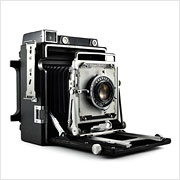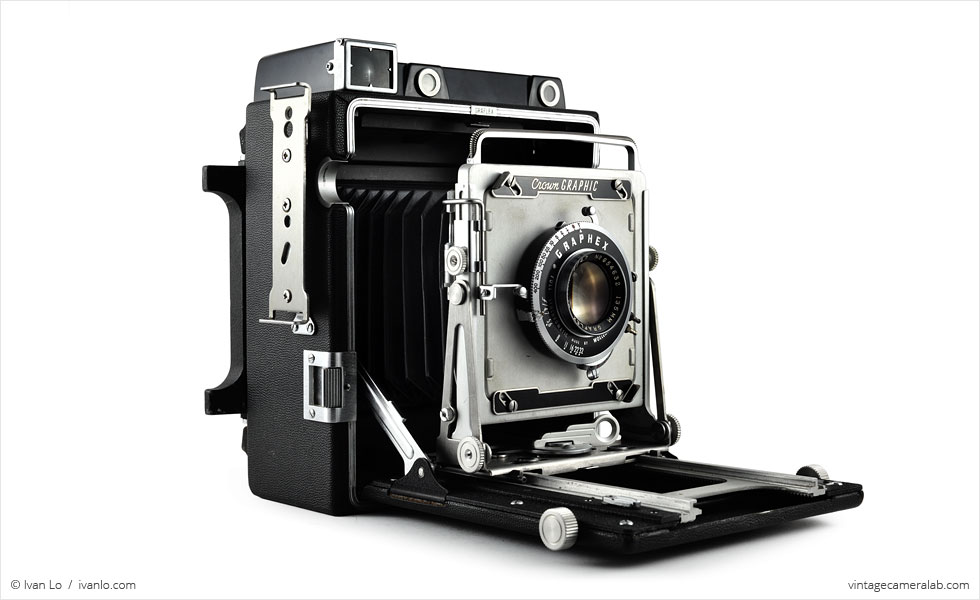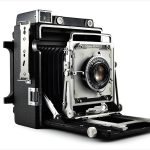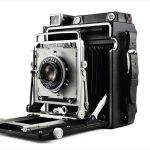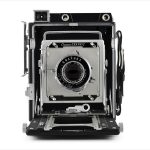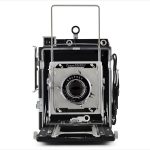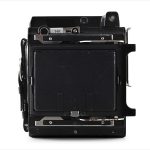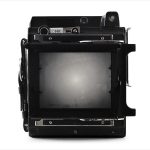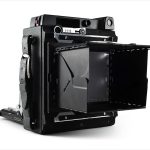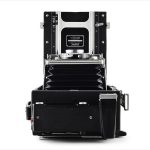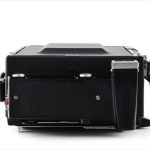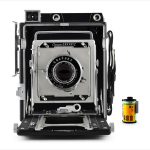Graflex Crown Graphic Specifications
| Manufacturer: | Graflex Inc. |
| Origin: | USA |
| Made in: | Rochester, NY, USA |
| Introduced: | 1947 |
| Type: | Folding, Rangefinder, View Camera |
| Format: | 4×5 Sheet Film |
| Dimensions: | 17 x 21.7 x 10 cm (closed) |
| 17 x 21.7 x 24 cm (open) |
Graflex Crown Graphic Overview
The Graflex Crown Graphic (also known as the Graflex Pacemaker Crown Graphic) is a large format press camera introduced by Graflex Inc. in 1947. The lesser known Crown Graphic is commonly mistaken for the Graflex Speed Graphic which is often regarded as the most famous press camera of all time. The mistake is easy to make, however, since the two cameras are identical apart from an additional focal plane shutter on the Speed.
Being a view camera, the Crown Graphic has a ground glass back (hidden under the folding viewfinder hood) which lets users know exactly how the image will appear on film. However, being also a press camera destined for the fast-paced world of journalism, the Crown is also equipped with an optical viewfinder and rangefinder assembly located on top of the camera as well as an extendable wire frame finder designed to be used in conjunction with a circular peep finder which can be adjusted for parallax correction. Although many different lenses can be mounted on the Crown Graphic, the one included is a Graflex Optar 135mm f/4.7 mated to a Graphex shutter capable of speeds ranging from one to 1/400 seconds, Time, and Bulb.
While a bit bulky, operation of the camera is fairly straightforward for what it is. The camera can be easily opened by pulling down on the silver focusing knobs on either side of the bed. Once the bed is fully extended and the braces lock it into place, release the sliding lock (the large silver switch underneath the lens) and pull the entire lens board outwards. Infinity stops—two small metal tabs along the rails that can be rotated into place—can be activated to stop the lens from being extended past the point where it would focus to infinity. Once the lens is at the infinity stops and the sliding lock is engaged, the focusing knobs can be used to fine-tune focus with the assistance of either the focusing scale near the outer edge of the bed, the rangefinder assembly, or the ground glass focusing screen on the back. Shutter speed and aperture are set on the lens and the shutter cocking mechanism can be found at the one o’clock mark. A shutter lock can be found at three o’clock which, when engaged, allows light to pass freely through the lens to project an image onto the ground glass focusing screen. At four o’clock are flash sync posts with a sync mode controller at five. The actual shutter switch is located at nine o’clock on the lens although it can also be triggered via the corrugated metal button on the user’s right hand side of the camera, located just underneath the flash mounting bracket. Threaded sockets for a cable release can be found both on the lens at the 11 o’clock position and the secondary shutter button.
Like any view camera, the Graflex Crown Graphic supports both tilting and shifting movements to the front standard to aid in perspective correction and controlling depth of field. However, tilting and shifting movements are of course limited due to the compact nature of the camera. The knobs located on the front standard directly to the right and left of the lens can be loosened to allow vertical travel while lateral travel can be achieved by pushing the small metal tab under the slide lock and pushing the lens board to the right or left. The lens can be tilted backwards by loosening the metal knobs at the base of the front standard on either side of the slide lock and can be tilted forwards by manipulating the braces to allow the entire bed to slant slightly downward. Unfortunately, there is no mechanism in place on the Crown Graphic to allow swing movements.
My friend John Almstedt found this camera for me at the St. Louis flea market where we had met the previous year. Knowing that I would be interested, he sent me photos of the camera and offered to purchase it on my behalf and ship it up to Chicago. After talking the seller down to a rock-bottom $100 for me, I agreed to buy the camera and it arrived in the mail a few days later. The Crown Graphic came with a large leather case, three 4×5 film holders, a cable release, a dark cloth, and a brief note from the seller. As an added bonus, there was an old, peeling label still half attached to the camera that indicated that it had indeed once been used by newspaper staff although for which news organization, I don’t know.
Lucky for me, the Crown Graphic probably would have been my press camera of choice anyway had I researched it on my own. The absence of a focal plane shutter makes it smaller and lighter than the Speed Graphic and also helps it to accommodate wider lenses: all bonuses in my book. I had been fantasizing about owning a press camera ever since I first got into photography so finally having one was like a dream come true. Thanks, John!
Find your very own Graflex Crown Graphic on eBay.
McKeown, James M. and Joan C. McKeown’s Price Guide to Antique and Classic Cameras, 2001-2002. (Grantsburg, WI, USA: Centennial Photo Service, 2001), p 258.
